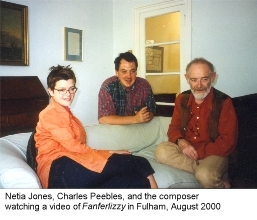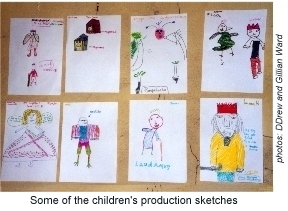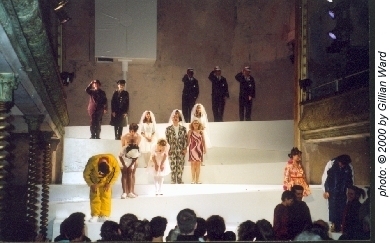|
|||||||||||||
|
Schwertsik's publishers, Boosey & Hawkes, invite you to visit their dedicated Composer and Repertoire site at www.boosey.com/composers and www.boosey.com/opera. In liaison with B&H, this page will provide additional information relating to specific works. Right now, in the spring of 2003, the Wuppertal Opera are preparing for their world premiere (1 June) of Schwertsik's Katzelmacher, based on the play by Rainer-Werner Fassbinder. Just under twenty years ago - on 23 November 1983 - Dennis Russell Davies conducted the highly successful world premiere in Stuttgart of Schwertsik's Fanferlieschen; and it was as long ago as May 1975 that two premiere productions - with only a day between them - of his Der lange Weg zur Grossen Mauer were staged in Ulm and in Lucerne. We're planning for a Lange Weg feature in anticipation of the opera's 30th birthday and the composer's 70th - which occur in May and June 2005 respectively. Meanwhile, here are some approaches to the recently re-discovered delights of Fanferlieschen.  DAS MÄRCHEN VON
FANFERLIESCHEN SCHÖNEFÜSSCHEN. Fanferlieschen was commissioned for the inauguration in 1983 of the Stuttgart Opera's new Kammertheater (architect, James Stirling) - a project initiated by the company's Chief Dramaturg, Peter Kehr. Intended for young audiences in the Christmas period, it captivated grownups as well. The Frankfurter Allgemeine Zeitung described it as "… an outstanding example of how one can without false ambitions or false primitiveness create a music theatre for children and adults alike." Revived season after season in Stuttgart, it seemed to confirm the words of another early reviewer: "At long last, Humperdinck's Hansel und Gretel has found a little companion". The original Stuttgart production was directed and designed by Axel Manthey. There have been subsequent productions in Germany and the Netherlands, but none in the USA. The first professional production of the English-language version was by Broomhill Opera at Wilton's Music Hall (a pre-Christmas run beginning on 6 December 2000). Associated with the production were workshops involving nearly 500 schoolchildren from St Paul's Way School and Mulberry School, Tower Hamlets. Their artwork provided the basis for Wayne Hemingway's costume designs. The conductor was Charles Peebles, the stage director Netia Jones.
The Story Version for busy people and latecomers Laudamus the Good, King of Scandalia, dies from shock when his loutish son Harum seizes power. Fanferlizzy comes to Scandalia's rescue with her magic powers, and after a big struggle, there's a happy ending. Longer version, for afternoon performances 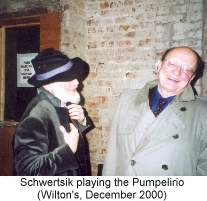
The story begins in a donkey-meadow outside Betterbee, the capital of Scandalia. It's the Annual Holiday, and King Laudamus is dishing out muesli to his adoring subjects. Suddenly, there's a palace revolution led by his son Harum. Harum's only interest is to seduce and do away with every innocent girl in Scandalia. Having disposed of them all, he calls for more. Fanferlizzy transforms her favourite goat, Miss Go-to-Wed, into a beautiful girl, and sends her to Harum's castle on a mission to reform him. But Harum realises who she is, and is about to stab her when he is foiled by his former Lord Chamberlain, now thoroughly repentant after Fanferlizzy has transformed him into a bird. Walled up in a tower on Harum's orders, Miss Go-to-Wed gives birth to Allingoodtime. In an instant, he's fully grown, and before long he has impressed Harum by building a magnificent castle-in-the-air during a single night. Already beginning to improve, Harum sacks his evil adviser, Pumpelirio Hobblebuck, and appoints Allingoodtime in his place. Allingoodtime defeats Hobblebuck in a ferocious battle, and Harum is finally humbled. He abdicates in favour of Allingoodtime, and Scandalia is restored to its old prosperity. Until the next time. Karin and Thomas Körner's trick-by-trick version (not suitable for grown-ups)
The last performances of Fanferlizzy are now over a month ago, but it strikes me there's still a lot to chew over and reflect on. There seemed to be a truly unique agreement between the reaction of musicians and the reaction of the audience (aged 7 - 70 as the programme suggested, but surely with the odd octogenarian and toddler as well). The piece is most unusual in the way it connects with so wide and disparate a group, without compromise to its own integrity. Something that functions on so many different levels should be set for immortality. So why has Fanferlizzy remained in the limbo for so long? 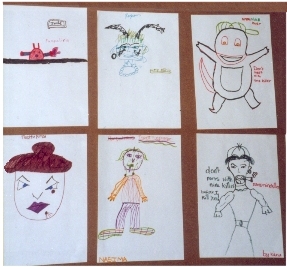
Clearly, there are some practical problems. At Wilton's we found some solutions which I believe may have a bearing on the work's future. The biggest of the problems is the size of the ensemble: a double chorus plus a large cast, is combined with a 16-piece band that clearly presupposes a relatively small auditorium. That means packing about 40 musicians into a confined space - a problem of overcrowding as well as of cost in relation to box-office income. By double-casting and by using the principals to sing the chorus music as an ensemble, where appropriate, we got away with a total cast of 14 (every singer having a named role, which is good for morale!). This made for a stronger continuity, and the singers felt they were telling the story in a way that would not have been possible otherwise. Rarely have I been involved in any new piece that has achieved such a large degree of audience and performer consensus across such a large sample of ages, backgrounds, and educations. I'm convinced that its early success was a good omen, and that after the long gap and then the rediscovery at Wilton's, it now has a great future Charles Peebles
The Band Between the scenes that are sung, the Fanferlizzy's orchestra has 'scenes' of its own, in which all sorts of strange things happen. The band itself is pretty strange: a collection of flutes, trumpets, and cellos, accompanied by piano, string bass, and a rhythm section - tom-toms, congas, a siren, a vibraphone, etc - and somewhere else, a solitary violin telling stories all its own, which are interrupted by a scary bass clarinet and a plump tuba. The band strikes up with a Little Overture that returns at the very end with a new tune in honour of Fanferlizzy. After the first singing-scene there's a Triom-phall March for Harum (who can't spell), and after the next one there's a disappointed version of the same march. To Muckleworst describes Lady-Go-to-Wed's journey through the dark woods, as if there were thorny, prickly, and scratchy things everywhere. After her meeting with Hobblebuck in the glen, it's a relief to hear the gentle Fanfare, which sounds like messages from Fanferlizzy. The band begins the second Act with a brisk little Prelude. After the scene with Throttlepumpa in the kitchen of Harum's castle, the band helps Allingoodtime build his Aerocastle Factory - the drumming tells us that it isn't in Europe or America. Parade leads back to Hobblebuck's glen. The last and most thoughtful of the band's scenes is Vigil - the night before the big fight, on which everything depends. But the band also takes part in the fight itself; and it has a treat in store for Allingoodtime's coronation. Collected together under the title Transformation Scenes, the band-pieces have become a popular concert-item. Karin and Thomas
Körner Kurt Schwertsik
|
|||||||||||||
|
Material Copyright © 2002 David Drew. |
|||||||||||||

